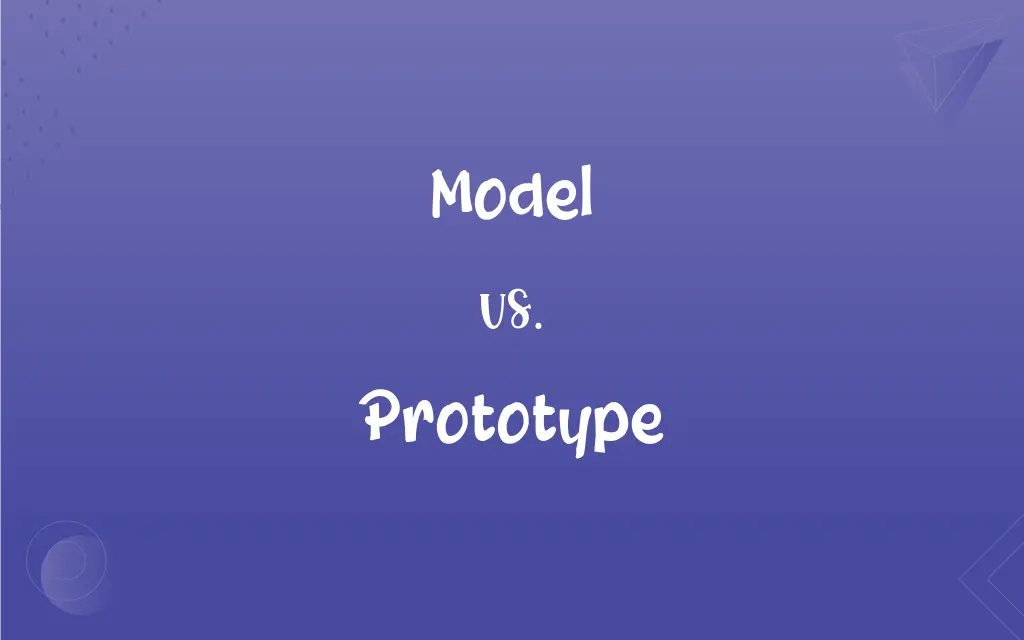Model vs. Prototype: What's the Difference?
Edited by Aimie Carlson || By Janet White || Published on November 23, 2023
Model refers to a representation or example of a concept, often smaller or simplified. Prototype refers to an original, full-scale, functional version of a new product or concept.

Key Differences
A model is typically a theoretical or physical representation used to demonstrate or explain a concept. On the other hand, a prototype is a preliminary version of a product, used to test and refine its functionality.
Models can be smaller or simplified versions of the actual product or concept, used for demonstration, teaching, or design purposes. While, prototypes are typically full-scale and functional, intended to test how the actual product will work.
Models can be used in the early stages of design to visualize or conceptualize an idea. Whereas, prototypes are developed after a concept has been somewhat established, to experiment with the real-world application.
Models may not include all the details and functionalities of the final product, focusing more on the overall design or concept. Meanwhile, prototypes are more complex, including operational features to simulate the actual product as closely as possible.
Models are used in various fields like architecture, education, and software design, often for visual or theoretical understanding. In contrast, prototypes are common in engineering, design, and software development, serving as a test bed for ideas and innovations.
ADVERTISEMENT
Comparison Chart
Purpose
For representation or demonstration.
For testing and refining functionality.
Physical Form
Often smaller or simplified.
Typically full-scale and functional.
Development Stage
Used in early conceptualization.
Developed for real-world testing.
Detail and Complexity
May lack full details or functions.
Close to the final product in complexity.
Usage in Fields
Used in a wide range of fields for various purposes.
Primarily in design and engineering for testing.
ADVERTISEMENT
Model and Prototype Definitions
Model
A representation, often smaller, of something for study or demonstration.
The architect created a model of the new building.
Prototype
An original or first model of something from which other forms are copied or developed.
The engineers tested the prototype of the new car.
Model
A particular design or version of a product.
She bought the latest model of the smartphone.
Prototype
A test model of a new product, especially a machine, used for improvements.
They created a prototype of the robot for testing its capabilities.
Model
An ideal example for imitation or comparison.
He is a role model for many young athletes.
Prototype
An early sample or model built to test a concept or process.
The prototype of the device was used for feasibility studies.
Model
A simplified mathematical representation of a system or process.
Scientists use climate models to predict future weather patterns.
Prototype
The first version of a product from which later stages are developed.
The prototype had many features that were altered in the final design.
Model
A person employed to display clothes or pose for an artist.
The fashion model walked down the runway.
Prototype
A preliminary version of a product used for demonstration and evaluation.
The software's prototype was presented at the tech conference.
Model
A small object, usually built to scale, that represents in detail another, often larger object.
Prototype
An original type, form, or instance serving as a basis or standard
"The abolitionists were the prototype of modern citizen activism" (Adam Hochschild).
Model
A preliminary work or construction that serves as a plan from which a final product is to be made
A clay model ready for casting.
Prototype
An original, full-scale, and usually working model of a new product or new version of an existing product.
Model
Such a work or construction used in testing or perfecting a final product
A test model of a solar-powered vehicle.
Prototype
A typical example of a class or category
"He fit the prototype of the artist as social misfit and compulsive contrarian" (Stephen Holden).
FAQs
How is a prototype used in product development?
It's used to test and refine a product before mass production.
Can a model be functional?
Yes, but it's often more for demonstration than practical use.
Do models always represent physical objects?
No, they can also represent systems or concepts, like in mathematics.
Is a prototype always the final version of a product?
No, it's an early version for testing and improvement.
Are models used in education?
Yes, they're used to illustrate and explain concepts.
What is a model in design?
It's a representation, often scaled-down, to visualize a concept.
Are models used in fashion the same as in engineering?
No, in fashion, it refers to people displaying clothes; in engineering, it's a physical representation.
Are prototypes more expensive to create than models?
Generally, yes, due to their complexity and functionality.
Can software have a prototype?
Yes, software prototypes are used to test features and usability.
Can anyone create a prototype?
Yes, but it requires knowledge of the product and its design.
Can a model evolve into a prototype?
Yes, a conceptual model can be further developed into a functional prototype.
Do architects use models or prototypes?
They typically use models to represent building designs.
Can prototypes be modified?
Yes, they are often modified based on testing results.
Is a model in science always accurate?
Models aim for accuracy but are simplifications of real phenomena.
How important is prototyping in innovation?
Very important; it allows for testing and refining ideas.
Is a prototype the same as a pilot?
Not exactly; a pilot is often a trial run, while a prototype is an initial version for testing.
Is a prototype used in market research?
Yes, it can be used to gauge consumer response and feasibility.
Are models used in decision-making?
Yes, particularly in strategic planning and analysis.
Can models be digital?
Yes, digital models are widely used in various fields.
Does a prototype have to be physical?
Not always; there can be digital or conceptual prototypes.
About Author
Written by
Janet WhiteJanet White has been an esteemed writer and blogger for Difference Wiki. Holding a Master's degree in Science and Medical Journalism from the prestigious Boston University, she has consistently demonstrated her expertise and passion for her field. When she's not immersed in her work, Janet relishes her time exercising, delving into a good book, and cherishing moments with friends and family.
Edited by
Aimie CarlsonAimie Carlson, holding a master's degree in English literature, is a fervent English language enthusiast. She lends her writing talents to Difference Wiki, a prominent website that specializes in comparisons, offering readers insightful analyses that both captivate and inform.






































































